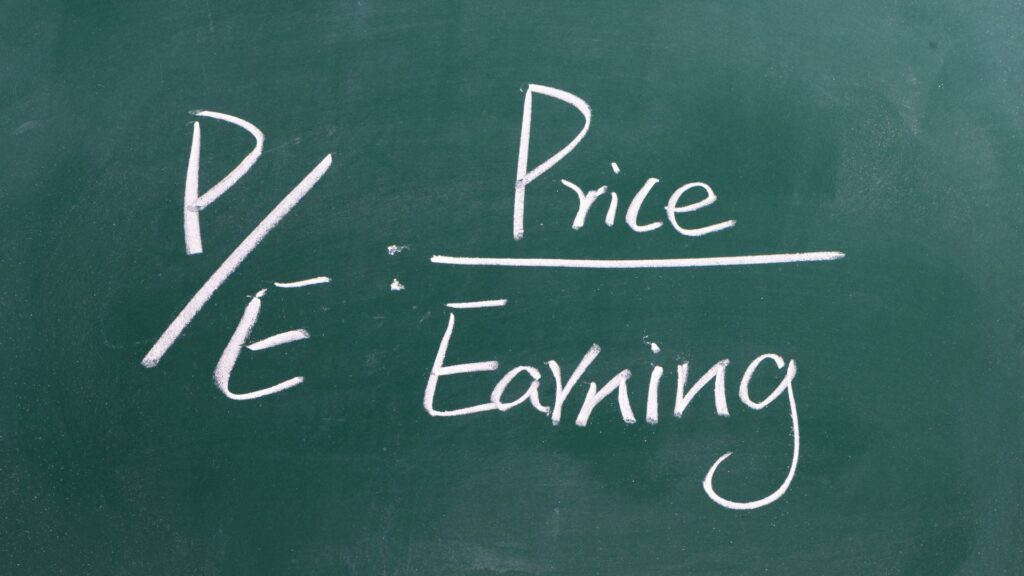
The Price-to-Earnings (P/E) ratio is one of the most widely used metrics in stock analysis, helping investors gauge the valuation of a company. Whether you’re a seasoned investor or a beginner, understanding it is essential for making informed investment decisions. This article delves into what the P/E ratio is, how to calculate it, its types, its significance, limitations, and how to use it effectively.
What is the P/E Ratio?
The P/E ratio is a valuation metric that compares a company’s current share price to its earnings per share (EPS). Essentially, it tells investors how much they are willing to pay for each dollar of the company’s earnings. Thi ratio can indicate whether a stock is overvalued, undervalued, or fairly priced relative to its earnings.
Formula
P/E Ratio = Market Price per Share / Earnings per Share (EPS)
- Market Price per Share: The current trading price of a company’s stock.
- Earnings per Share (EPS): The portion of a company’s profit allocated to each outstanding share of common stock. It can be calculated as:
EPS = (Net Income − Dividends on Preferred Stock) / Average Outstanding Shares
Types of P/E Ratios
There are two primary types of P/E ratios that investors commonly use:
1. Trailing P/E Ratios
The trailing P/E ratio uses earnings from the past 12 months (also known as the trailing twelve months or TTM). It reflects the company’s historical earnings performance and is the most frequently cited earnings ratio.
2. Forward P/E Ratios
This ratio uses projected earnings for the upcoming year. Analysts often use forward P/E to estimate future performance based on expected growth, making it useful for growth stocks.
Significance of the P/E Ratio
1. Valuation Indicator
The P/E ratio helps investors assess whether a stock is fairly valued. A high P/E may indicate that a stock is overvalued, while a low P/E could suggest it is undervalued.
2. Comparison Tool
It is useful for comparing companies within the same industry. It allows investors to identify which companies are cheaper relative to their earnings potential.
3. Growth Expectations
Investors often consider the P/E ratio in conjunction with growth expectations. A high P/E may be justified for companies with strong growth prospects, while a low P/E might be warranted for companies with stagnant or declining earnings.
4. Market Sentiment
P/E ratios can reflect market sentiment. A rising ratio often indicates investor optimism, while a declining might signal pessimism about future earnings.
Limitations of the P/E Ratio
1. Earnings Manipulation
Earnings can be influenced by accounting practices and one-time events, potentially skewing the P/E ratio. Companies might use aggressive accounting techniques to inflate their earnings, making the ratio misleading.
2. Ignores Growth
The P/E ratio does not take into account a company’s growth rate. A company with a high P/E might have better growth prospects than one with a low ratio, but the ratio alone does not capture this dynamic.
3. Varied Industry Norms
Different industries have different average P/E ratios. A high P/E ratio in one industry may be standard in another. Therefore, it’s crucial to compare P/E ratios within the same sector.
4. Non-Earnings Companies
For companies that do not have earnings (e.g., start-ups or companies in distress), the P/E ratio becomes meaningless. In such cases, other valuation metrics should be used.
Stock Valuation: Overvalued, Undervalued, and Fairly Valued
Determining whether a stock is overvalued, undervalued, or fairly valued is crucial for informed investing. This assessment is influenced by several assumptions regarding valuation metrics, especially the P/E ratio.
Overvalued Stocks
A stock is generally considered overvalued when its P/E ratio significantly exceeds industry averages. Here are some key indicators:
- High P/E Ratio: Above 20-25 can signal overvaluation, suggesting investors are paying too much for each dollar of earnings.
- Unsustainable Growth Expectations: Overvaluation often stems from unrealistic growth projections. If a company’s growth prospects appear overly optimistic, it may lead to inflated prices.
- Market Sentiment: Stocks can become overvalued due to speculative trading, often seen in bubbles, where investors buy not based on fundamentals but on the expectation that prices will continue to rise.
Undervalued Stocks
In contrast, a stock is considered undervalued when its price is below its intrinsic value. Indicators include:
- Low P/E Ratio: Under 15, especially in stable industries, often suggests a stock is undervalued, indicating that the market may not fully recognize the company’s earnings potential.
- Strong Fundamentals: A company with solid earnings, revenue growth, and manageable debt trading at a low P/E ratio may represent an undervalued opportunity.
- Market Inefficiencies: Behavioral biases can create situations where stocks are undervalued, often due to market fear or lack of analyst coverage.
Fairly Valued Stocks
A stock is deemed fairly valued when its price aligns closely with its intrinsic value:
- Moderate P/E Ratio: Between 15 and 20 typically indicates fair valuation, reflecting a balanced assessment of the company’s performance and growth potential.
- Consistent Earnings: Companies with stable earnings growth that match market expectations often fall into this category.
- General Market Consensus: When analysts and investors generally agree on a stock’s price based on comprehensive research, it signals fair value.
Insights from Benjamin Graham
Benjamin Graham, the father of value investing, emphasized intrinsic value and disciplined analysis. He suggested:
- Margin of Safety: Invest in stocks priced significantly below intrinsic value to reduce risk. For Graham, a low P/E ratio (under 15) often signified such opportunities.
- Focus on Fundamentals: Thoroughly analyze financial statements and management quality to uncover hidden value.
- Market Behavior: Graham advised investors to view market fluctuations as opportunities, taking advantage of prices lower than intrinsic value.
How to Use it Effectively
1. Compare with Peers
Use this ratio to compare a company with its peers in the same industry. This can help you determine if a stock is overvalued or undervalued relative to its competitors.
2. Look for Trends
Observe trends in a company’s P/E ratio over time. A consistently rising ratio might indicate growing investor confidence, while a declining could signal issues.
3. Combine with Other Metrics
Don’t rely solely on this metric. Combine it with other financial metrics like the Price-to-Book (P/B) ratio, Debt-to-Equity ratio, and Return on Equity (ROE) to gain a more comprehensive view of a company’s financial health.
4. Consider Growth Rates
When evaluating growth stocks, consider the PEG (Price/Earnings to Growth) ratio, which adjusts the P/E ratio by the company’s expected earnings growth rate. This provides a more nuanced view of valuation.
5. Analyze Index P/E Ratios for Market Insight
Beyond individual stocks, examining the P/E ratios of major stock indexes can provide valuable insights into overall market valuation. For instance, a historically high P/E ratio for an index like the S&P 500 may suggest that the broader market is overvalued, potentially signaling caution. Conversely, a low index P/E might indicate undervaluation and potential opportunity. This macro-level perspective is useful for timing market entry or adjusting asset allocation strategies. You can monitor current index P/E ratios across global markets using resources like World P/E Ratio.
Conclusion
The P/E ratio is a fundamental tool for investors seeking to evaluate the relative value of stocks. While it has its limitations, when used wisely in conjunction with other financial metrics and in the context of industry norms, it can provide valuable insights into a company’s valuation and growth potential. Understanding it can empower investors to make informed decisions and navigate the complexities of the stock market more effectively.



